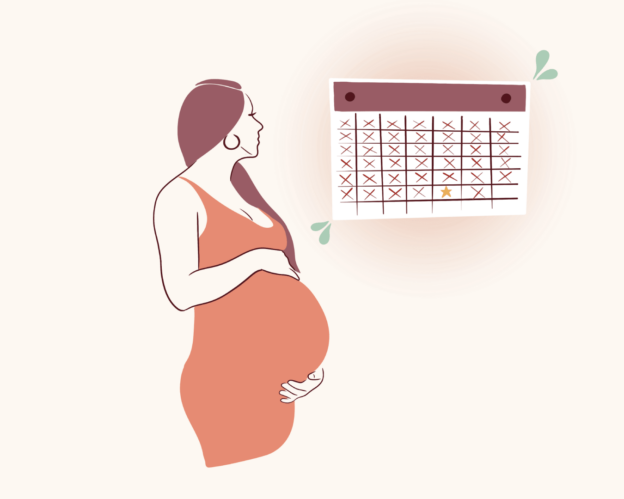
Geschreven door Lisette Nijenhuis
Gepubliceerd op: 12 april 2024
Laatste update op: 12 april 2024
Slechts 5% van de vrouwen bevalt op de uitgerekende datum. Ondanks dat deze datum slechts een benadering en geen vast gegeven is, staat ‘ie vaak met een uitroepteken in de agenda van zowel de aanstaande ouders als de zorgverlener. Dit heeft in de geboortezorg concrete gevolgen, omdat aan de hand van de zwangerschapsduur planningen gemaakt, afspraken ingepland en complicaties in kaart gebracht worden.
In Nederland wordt er gesproken van een á terme bevalling als je bevalt tussen de 37 en de 42 weken zwangerschap. De uitgerekende datum is gebaseerd op de aanname dat een zwangerschap gemiddeld veertig weken (of 280 dagen) duurt na de eerste dag van de laatste menstruatie. Recenter onderzoek laat echter zien dat die veertig weken niet kloppend zijn, met name omdat het gebruikte rekensommetje geen rekening houdt met de lengte van de maand dat iemand zwanger wordt (en dat scheelt zo maar een paar dagen). Een paar dagen verschil klinkt niet veel, maar kan een groot verschil in beleid betekenen bij bijvoorbeeld (dreigende) vroeggeboorte (onder de 37 weken) of ‘overtijd’ gaan (vanaf 42 weken).
In plaats van te tellen vanaf de eerste dag van de laatste menstruatie kan de uitgerekende datum ook worden vastgesteld door te tellen vanaf de ovulatie of gebruik te maken van echoscopie (de termijnecho vindt plaats tussen 10-13 weken zwangerschap).
Naast onnauwkeurigheid en protocollen rondom medische interventies zijn er nog meer nadelen aan het vaststellen van de uitgerekende datum; het is een technocratische benadering van een fysiologisch proces dat een grote variatie kent en kan stress veroorzaken bij zowel de zwangere, als haar partner, als haar omgeving. Er zijn ook voordelen aan het hebben van een uitgerekende datum: er is een moment om naar toe te leven en het geeft een richtlijn bij met het regelen van de praktische voorbereiding en het organiseren van zorg rondom de bevalling (denk aan het bestellen van een kinderwagen en het regelen van kraamzorg tot ). Daarnaast geeft een uitgerekende datum concrete handvatten voor zorgverleners om mogelijke complicaties in kaart te brengen, zoals prematuriteit of overtijd gaan (serotiniteit).
Meer over de voor- en nadelen van de uitgerekende datum lees je in het uitgebreide artikel.
Inhoud volledige artikel:
- Wat is de uitgerekende datum?
- Wat zijn de voor- en nadelen van de uitgerekende datum?
- Welke manieren zijn er om de uitgerekende datum te berekenen en hoe effectief zijn deze?
- Welke factoren zijn van invloed op de duur van de zwangerschap?
- In hoeverre is etniciteit van invloed op de zwangerschapsduur?
- Hoe is de uitgerekende datum ontstaan?
- Wat zegt recenter onderzoek over de uitgerekende datum?
- Welke alternatieven zijn er?
Nog geen lid van Vraag de Vroedvrouw maar wel benieuwd naar het hele artikel? Word nu lid!

American Society for Reproductive Medicine (2021). Diagnosis and treatment of luteal phase deficiency: A committee opinion. Fertility and Sterility, 115(6), 1416–1423. https://doi.org/10.1016/j.fertnstert.2021.02.010.
Bergsjø, P., Denman, D. W., Hoffman, H. J., & Meirik, O. (1990). Duration of human singleton pregnancy: a population-based study. Acta Obstetricia et Gynecologica Scandinavica, 69(3), 197–207. https://doi.org/10.3109/00016349009028681.
Baskett, T. F., & Nagele, F. (2000). Naegele’s rule: a reappraisal. BJOG: An International Journal of Obstetrics and Gynaecology, 107(11), 1433–1435. https://doi.org/10.1111/j.1471-0528.2000.tb11661.x.
Caughey, A. B., Stotland, N. L., Washington, A. E., & Escobar, G. J. (2009). Who is at risk for prolonged and postterm pregnancy? American Journal Of Obstetrics And Gynecology, 200(6), 683.e1-683.e5. https://doi.org/10.1016/j.ajog.2009.02.034.
Dekker, R. (2023, 9 juli). Evidence on: Due dates - Evidence based birth®. Evidence Based Birth®. https://evidencebasedbirth.com/evidence-on-due-dates/.
Divon, M. Y., Haglund, B., Nisell, H., Otterblad, P. O., & Westgren, M. (1998). Fetal and neonatal mortality in the postterm pregnancy: The impact of gestational age and fetal growth restriction. American Journal Of Obstetrics And Gynecology, 178(4), 726–731. https://doi.org/10.1016/s0002-9378(98)70482-x.
Jukic, A. M. Z., Baird, D. D., Weinberg, C. R., McConnaughey, D. R., & Wilcox, A. J. (2013). Length of human pregnancy and contributors to its natural variation. Human Reproduction, 28(10), 2848–2855. https://doi.org/10.1093/humrep/det297.
Kagan, K. O., Hoopmann, M., Baker, A., Huebner, M., Abele, H., & Wright, D. (2012). Impact of bias in crown–rump length measurement at first‐trimester screening for trisomy 21. Ultrasound in Obstetrics & Gynecology, 40(2), 135–139. https://doi.org/10.1002/uog.11095.
Khambalia, A., Roberts, C. L., Nguyen, M., Algert, C. S., Nicholl, M. C., & Morris, J. M. (2013). Predicting date of birth and examining the best time to date a pregnancy. International Journal of Gynecology & Obstetrics, 123(2), 105–109. https://doi.org/10.1016/j.ijgo.2013.05.007.
Lawson, G. (2020). Naegele’s Rule and the length of pregnancy – a review. Australian and New Zealand Journal of Obstetrics and Gynaecology, 61(2), 177–182. https://doi.org/10.1111/ajo.13253.
Loytved, C., & Fleming, V. (2016). Naegele’s rule revisited. Sexual & Reproductive Healthcare, 8, 100–101. https://doi.org/10.1016/j.srhc.2016.01.005.
Mahendru, A., Daemen, A., Everett, T. R., Wilkinson, I. B., McEniery, C. M., Abdallah, Y., Timmerman, D., Bourne, T., & Lees, C. (2012). Impact of ovulation and implantation timing on first-trimester crown-rump length and gestational age. Ultrasound in Obstetrics & Gynecology, 40(6), 630–635. https://doi.org/10.1002/uog.12277.
Mittendorf, R., Williams, M. A., Berkey, C. S., Lieberman, E., & Monson, R. R. (1993). Predictors of human gestational length. American Journal of Obstetrics and Gynecology, 168(2), 480–484. https://doi.org/10.1016/0002-9378(93)90476-y.
Mongelli, M., Wilcox, M., & Gardosi, J. (1996). Estimating the date of confinement: Ultrasonographic biometry versus certain menstrual dates. American Journal Of Obstetrics And Gynecology, 174(1), 278–281. https://doi.org/10.1016/s0002-9378(96)70408-8.
Morken, N., Klungsøyr, K., & Skjærven, R. (2014). Perinatal mortality by gestational week and size at Birth in Singleton Pregnancies at and Beyond Term: A nationwide population-based cohort study. BMC Pregnancy and Childbirth, 14(1). https://doi.org/10.1186/1471-2393-14-172.
National Childbirth Trust (2023, 17 november). Pregnancy Week 1 | Pregnancy, Your Pregnancy Week by Week Articles & Support | NCT. NCT (National Childbirth Trust). https://www.nct.org.uk/pregnancy/your-pregnancy-week-week/first-trimester/pregnancy-week-1#:~:text=In%20France%20pregnancy%20is%20counted,on%20the%20due%20date%20calculated.
NVOG (2018). Protocol datering van de zwangerschap.
Olesen, A. V., Basso, O., & Olsen, J. (2003). Risk of recurrence of prolonged pregnancy. The BMJ, 326(7387), 476. https://doi.org/10.1136/bmj.326.7387.476.
Öberg, S., Frisell, T., Svensson, A., & Iliadou, A. (2013). Maternal and Fetal genetics
contributions to Postterm birth: familial clustering in a Population-Based sample of 475,429
Swedish births. American Journal of Epidemiology, 177(6), 531–537. https://doi.org/10.1093/aje/kws244.
Papiernik, E., Alexander, G. R., & Paneth, N. (1990). Racial differences in pregnancy duration and its implications for perinatal care. Medical Hypotheses, 33(3), 181–186. https://doi.org/10.1016/0306-9877(90)90173-c.
Patel, R. (2004). Does gestation vary by ethnic group? a London-based study of over 122 000 pregnancies with spontaneous onset of labour. International Journal of Epidemiology, 33(1), 107–113. https://doi.org/10.1093/ije/dyg238.
Robinson, H. P., & Fleming, J. E. E. (1975). A CRITICAL EVALUATION OF SONAR “CROWN‐RUMP LENGTH” MEASUREMENTS. BJOG: An International Journal Of Obstetrics And Gynaecology, 82(9), 702–710. https://doi.org/10.1111/j.1471-0528.1975.tb00710.x
Smith, G. C. S. (2001). Use of time to event analysis to estimate the normal duration of human pregnancy. Human Reproduction, 16(7), 1497–1500. https://doi.org/10.1093/humrep/16.7.1497.
Stotland, N. L., Washington, A. E., & Caughey, A. B. (2007). Prepregnancy body mass index and the length of gestation at term. American Journal Of Obstetrics And Gynecology, 197(4), 378.e1-378.e5. https://doi.org/10.1016/j.ajog.2007.05.048.
Su, H., Yi, Y., Wei, T., Chang, T., & Cheng, C. (2017). Detection of ovulation, A review of currently available methods. Bioengineering & translational medicine, 2(3), 238–246. https://doi.org/10.1002/btm2.10058.
Taipale, P., & Hiilesmaa, V. (2001). Predicting delivery date by ultrasound and last menstrual period in early gestation. Obstetrics & Gynecology, 97(2), 189–194. https://doi.org/10.1016/s0029-7844(00)01131-5.
Treloar, A. E., Behn, B. G., & Cowan, D. W. (1967). Analysis of gestational interval. American Journal of Obstetrics and Gynecology, 99(1), 34–45. https://doi.org/10.1016/s0002-9378(16)34488-x.
Tuck, S. M., Cardozo, L., Studd, J., Gibb, D. M. F., & Cooper, D. J. (1983). Obstetric characteristics in different racial groups. BJOG: An International Journal of Obstetrics and Gynaecology, 90(10), 892–897. https://doi.org/10.1111/j.1471-0528.1983.tb06759.x.
Weiß, G. N. F., Strohmayer, K., Koele, W., Reinschissler, N., & Schenk, M. (2022). Confirmation of human ovulation in assisted reproduction using an adhesive axillary thermometer (FEMSense®). Frontiers in digital health, 4. https://doi.org/10.3389/fdgth.2022.930010.
Whitworth, M., Bricker, L., & Mullan, C. (2015). Ultrasound for fetal assessment in early pregnancy. The Cochrane library, 2015(7). https://doi.org/10.1002/14651858.cd007058.pub3.
Wilcox, M., Gardosi, J., Mongelli, M., Ray, C., & Johnson, I. R. (1993). Birth weight from pregnancies dated by ultrasonography in a multicultural British population. BMJ, 307(6904), 588–591. https://doi.org/10.1136/bmj.307.6904.588.




